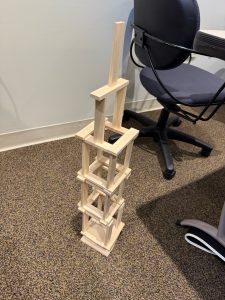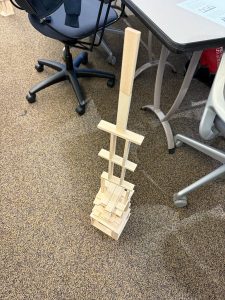Saturday SAVY, Day 2 – “If Walls Could Talk…” (3rd/4th)
Hello! I’m always amazed at how much we accomplish in these SAVY classes. The pace is fast, and the content is jam-packed. We covered many concepts and ideas, and many tasks were challenging, but we did it. I’m so proud of this group.
We started the day by completing a brief lesson on skyscrapers, and the students had another KEVA building challenge, which they loved. Each group had 50 planks, and their task was to create the tallest tower in 10 minutes. I loved watching them work, talk, and rebuild their towers over and over as they experimented.
We then moved on to 2 lessons on iconic structures in film & literature. We had a brainstorming activity where the students had to think of as many structures as they could in works of fiction—not just any structures, but those that were integral to the story. As the students shared, they had to articulate what “meaning” the structures had within the story and what they represented symbolically to the characters, viewers, or the reader. This “symbolic thinking” was tricky for the students. It’s an advanced task that we stayed with throughout different activities all day. We then viewed various structures—real or imagined—and the students had to focus on what the structure made them “feel”. This was fascinating due to the fact that most students had the same reaction to the images, and they realized that structures could be powerful and set the mood or tone of fiction–again, another advanced skill.
To prepare the students for next week’s final project, we completed a lesson on story structure and filled out a graphic organizer of the plot of The Wizard of Oz, discussing what the Emerald City represented in the story. All agreed that it symbolized “hope” as well as “awe” or “fear”. We did a deep dive on one of the passages from the written work and completed the story structure graphic organizer. As you view or read stories with the students in the next week, you might want to check to see if they can identify the components of story structure—beginning, rising action, climax, falling action, and denouement (or ending). How do we identify each of these parts of the story?
After lunch, we had another symbolic thinking “tournament,” where real structures took on fictional iconic structures, and we had to determine which had the most “symbolic” meaning. It was a serious challenge! By the end, they all got it, and Hogwarts won! They determined that Hogwarts represented understanding and development of personality or self, and growing up. The tournaments are always a lot of fun. The students barely realize how much they are learning in these tasks.
To end the day, we played an inductive reasoning game that introduced the students to several character archetypes—hero, anti-hero, mentor, sidekick, and loveable rogue. Again, challenge your children to see if they can identify these. Plot structure and character archetypes will be a big part of next week’s final project.
Next week, the students will choose to create a structure in the style of one of the architectural periods we discussed, AND write a story following a clear plot structure with character archetypes. They will create a watercolor of their structure and write a complete story. At the student’s request, we will also do a lesson on Frank Lloyd Wright (always a favorite!) to start the day.
Looking forward to next week!


